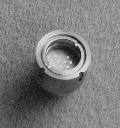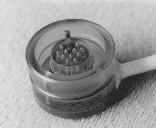
(click picture for enlarged view)
The Percutaneous Connector
The Titanium Pedestal:
The percutaneous connector has been developed jointly by UCL and
Nobel Biocare AB. The picture below shows the titanium pedestal (Carlsson et al.,1995),
alongside a one cent piece for size comparison.

The 'threaded' portion of the titanium pedestal is initially fixed
into the temporal bone by virtue of it's tapered design. During
bone remodelling the bone ingrowth into the Brånemark System®
thread profile osseointegrates the pedestal within the temporal
bone. The skin immediately surrounding the implant, normally
7-8mm thick, is thinned to reduce movement (and hence limit the
possibility of infection) and seats around the angled portion
of the main body of the pedestal. The skin break is 6mm diameter. Percutaneous titanium implants have very good clinical results for the reaction of the
surrounding soft tissue and osseointegration (see for example Holgers et al., 1994 and
Tjellström and Granström, 1995). Histological data for the pedestal has shown very good
results (Downing et al., 1997).
The main body of the pedestal will be approximately 10mm proud
of the bone height. A groove will be included to seat an o-ring
to prevent ingress of fluid when the external connector is mated.
The internal connector plate and the locking ring can be clearly
seen in the picture below. The connector plate is made from commercially
pure alumina, with platinum-iridium (80-20%) pins glassed in and
ground. This provides a flat contact surface that is both hard
wearing and easy to clean. In the prototype the plate offers
11 contacts but it is expected to increase this number substantially
with only minor internal design modifications. The locking ring
can be seen to incorporate a profiled groove that is used by the
external connector for latching (see later). Locating grooves
can also be seen that positively locate the external connector.

The Electrode Array:
The electrode array will be based on the proven electrode technology
used in the commercial cochlear implants. It is proposed that
UCLID electrode array has 9 single contacts (or a combination
of single- and pair-contacts) and 2 indifferent earths. The wire
and contact material is platinum-iridium (90-10%), contained in
a silastic carrier. The electrode array is connected to the pins
on the back face of the connector plate and it, together with
the titanium pedestal assembly, is supplied as a complete unit.
Differing electrode array configurations could be incorporated
depending on the neural application.
The External Connector:
The external connector pictured below has been developed between
UCL and Cinch Connectors Limited, based on their proven CIN::APSE
technology. The connector offers a very low profile with the
high density of contacts needed. The plunger has a soft gold
coating and spring for the contact is a gold coated molybdenum
'brillo pad'. The offset pin provides an earthing route to discharge
any static electricity through the canted-coil latching spring
into the pedestal body. The spring, as well as providing the
connecting force for the contacts, also provides a trauma release
mechanism. The locating tongues can seen to match the connector
with the pedestal.

Holgers, K.-M., Thomsen, P., Tjellström, A., Ericson, L.E., Bjursten, L.-M. International Journal of Oral & Maxillofacial Implants, 1994; vol. 9: 689-697.
Tjellström, A., Granström, G. Journal of Laryngology and Otology, 1995; vol. 109: 593-598.
Downing, M., Johansson, U., Carlsson, L., Walliker, J.R., Spraggs, P.D.R., Dodson, H., Hochmair-Desoyer, I.J., Albrektsson, T. Ear, Nose & Throat Journal, 1997; vol. 76: 752- 755.
Link to Speech Hearing and Language paper.